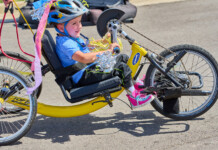By Steph Meyer — “Nothing compares to the simple pleasure of riding a bike,” said John F. Kennedy. But for those with disabilities, this statement often holds even more truth.
Here, in the cycling mecca of Park City, Utah, the National Ability Center is making that simple pleasure accessible to all and proudly offers one of the largest fleets of adaptive bikes in the nation. On the trails and roads near NAC, you may encounter recumbent or hand-powered cycles, which sit close to the ground and roll on three wheels rather than two – these are great for individuals with balance concerns, as well as cyclists riding with spinal cord injuries, amputations and more. Or you may be overtaken by a team of cyclists, one with a visual impairment, pedaling in sync on a tandem.
But specialized equipment is just one piece of the picture.

At the NAC, we encourage individuals to take the leap into adaptive cycling by providing hands-on guidance and preparation through a multi-step approach which empowers cyclists with both physical or cognitive disabilities to ride through the mountains, on trails and through local roads using this innovative, adaptive equipment or a “standard” upright bike. When first-time participants inquire about lessons, someone from the NAC program team speaks directly with them to learn more about their background, skill and comfort level. From there, our team is dedicated to ensuring each rider, no matter their ability, has the opportunity to experience Utah’s outdoors while striving towards personal goals and learning new activities, including cycling, mountain and fat tire biking.
At the NAC, we routinely hear from riders how adaptive cycling “makes them feel normal again” – allowing them to forget they have a disability, if only for a couple of hours. Those of us who cycle can agree that riding with the breeze in your face and being able to do that independently is a feeling like none other.

We tapped into our network to ask about the emotions cyclists experience when they bike with the NAC. Maggie Gettys has a spinal cord injury, and recently joined the NAC team as a recreation instructor to provide handcycling lessons. Maggie spoke to how the cycling program has impacted her over the years, saying “The NAC cycling activities — whether it be on the road or the Round Valley trails — gives me the chance to see amazing views. Some of the views I wouldn’t have been able to access in my wheelchair, so having the NAC staff guide us there in bikes is a special experience. It’s hard work and takes lots of balance and concentration, but the reward of feeling your heart pumping and blood flowing is so great!”
These moments give people of all backgrounds and abilities the opportunity to step away from the “I can’ts” in life and to say, “I can,” opening doors to get out and play again.

Like many riders, adaptive riders face the number one barrier to entry in the cycling world — access to high-caliber equipment. In fact, most adaptive bikes start at several thousand dollars, can be difficult to transport and aren’t typically sold at your local bike shop. That’s where organizations like the National Ability Center come in. We help riders get started, connect them with sources for these highly specialized cycles, allow them to try a range of equipment and eliminate the barrier to entry so they can ride at little to no cost in comparison to the steep cost of adaptive cycles. Through grants and support from organizations like the Kelly Brush Foundation, Vail EpicPromise and other corporate and community supporters, the NAC and countless other organizations are able to offer these tools, while guiding riders on life-changing outdoor recreation experiences.
Cycling is an amazing opportunity for adventure and I highly suggest you get involved or branch out to try new disciplines of cycling if you can. My favorite four tips for success are:
- Don’t be scared to try: everyone has their first day on the bike.
- Find someone who you want to adventure with and bring them with you.
- Make room for progress: practice and pedal, because cycling can take you to a lot of places
- Like bikes, cyclists come in all shapes, sizes, colors, ages and aspirations. Whether you are cruising for a mile or taking on a century, embrace your inner cyclist.
I challenge you to see how outdoor adventures, like cycling, can positively impact your life – and the lives of those around you. Make it a goal to get out and pedal, but also to invite someone new to the sport to discover the rush of freedom it provides.
Steph Meyer is the Recreation and Adventure Program Manager at the National Ability Center











